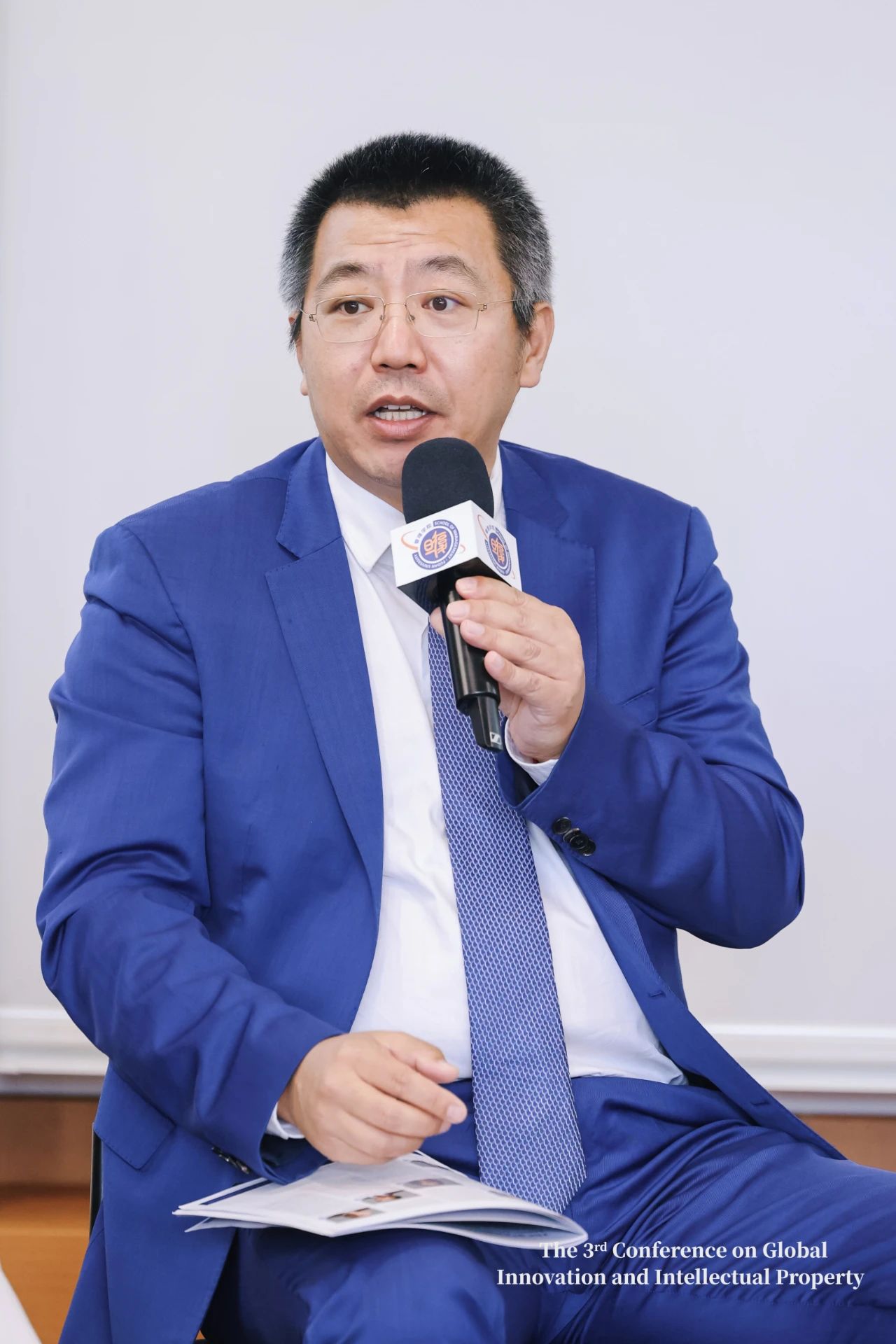#本文仅代表作者观点,不代表IPRdaily立场#
“面对高人员流动性带来的商业秘密泄露风险,企业可借鉴日本终身雇佣模式,通过构建长期信任关系降低泄密隐患。在技术获取路径上,齐宝鑫主张多元化策略,将自主研发的深度与校企合作、成果转化的广度相结合,以提升效率并分散风险。针对AI技术对知识产权法的冲击,他提出应以“创意参与度”作为独创性判定标准,同时呼吁法律框架保持开放性与适应性。此外,齐宝鑫以国产化C919客机为例,指出自主创新是突破国际技术壁垒的核心路径;而在高风险研发管理中,他建议依托商业秘密确权机制与哈希值技术,强化核心数据保护,尤其需警惕跨国合作中的技术外溢风险。”
来源:IPRdaily中文网(iprdaily.cn)
2025年5月18日,由复旦大学管理学院、华盛顿大学麦克道尔国际学者研究院、北京大学光华管理学院、华盛顿大学奥林商学院联合主办的第三届全球创新与知识产权论坛在中国上海复旦大学管理学院圆满落幕。齐宝鑫博士代表IPR Daily作为嘉宾受邀参会,并在“商界领袖的声音”环节分享前沿见解。

附:发言全文(双语)
Q:您认为当今知识产权战略面临的主要挑战和趋势有哪些?
What are the key challenges and trends you see today in IP strategy?
A:基于我的工作经验,当下知识产权战略面临的挑战之一就是较高的人员流动性带来的知识产权保护问题。这一挑战也反映出当下知识产权战略调整的一个趋势就是商业秘密的重要性愈发凸显。在一个企业中研发总监和销售总监总是能有一份不错的薪资待遇,因为他们通常掌握着一个企业的技术秘密和经营秘密。如何保护这些商业秘密是随之而来的一个重要问题。日本传统的终身雇佣制度,为商业秘密的保护提供了极具参考价值的实践样本。这一制度基于长期劳动合同关系,构建起企业与员工之间稳定的法律契约,员工自入职起便与企业形成贯穿职业生命周期的权利义务关系。再没有比一个工程师东京大学毕业就进入丰田公司从事研发,一直到退休,从未进入过丰田竞争对手的公司,更能保护丰田的商业秘密了。从知识产权保护视角审视,该制度呈现出三重法律优势:首先,员工忠诚度高,泄密风险低。长期服务于同一企业的员工更容易形成归属感和责任感,他们对公司机密信息的保护意识也更强,从而减少了故意泄密或“跳槽带走技术”的风险。其次,知识流动受控,保密链条更稳定。相比频繁更换工作的环境,终身雇佣减少了核心技术和商业信息在行业内的频繁流动,保护了企业的研发成果和战略布局。最后,企业更愿意投入培训和信任。由于员工不会轻易离职,企业可以放心将关键技术、管理经验传授给员工,这在加强团队能力的同时,也建立了更紧密的信任关系,从制度上降低了因信息外泄而造成的损失。这种终身雇佣制度能够有效降低人员流动这一商业秘密泄露主要原因带来的风险。当然,终身雇佣制并不一定完全适合国内环境,但是它提供了一个降低商业秘密泄露风险的思路,可以作为我们知识产权保护的一个重要参考。
From my work experience, one of the key challenges that IP strategies are facing is the issue of IP protection arising from high workforce mobility. This challenge also reflects an emerging trend in contemporary IP strategy adjustments - the increasing importance of trade secrets. Within enterprises, R&D Directors and Sales Directors usually can get high salaries, mainly because they have a knowledge of a company’s technical secrets and business secrets. How to protect these trade secrets has consequently become a critical issue.Japan's traditional lifetime employment system offers an instructive model for trade secret protection. This system establishes stable legal contractual relationships through long-term employment, creating career-long rights and obligations between enterprises and employees from recruitment to retirement. There is nothing more effective in protecting Toyota's trade secrets than having an engineer who, upon graduating from the University of Tokyo, joins Toyota's R&D department and stays there till retirement, without ever transitioning to any Toyota's competitors.From an IP protection perspective, this system demonstrates three legal advantages: Firstly, employee loyalty will be high, and the risk of information leakage will be low. Employees who have served the same enterprise for a long time are more likely to develop a sense of belonging and responsibility. They also have a stronger awareness of protecting the company's confidential information, thus reducing the risk of deliberate leakage of secrets or taking technologies when changing jobs. Secondly, the spread of knowledge will be controlled, and the confidentiality chain will be more stable. Compared with an environment where employees change jobs frequently, lifetime employment reduces the frequent dissemination of core technology and business information within industries, preserving R&D achievements and strategic layouts of the company. Thirdly, the company will be more willing to invest in training and place trust. Since employees are not likely to leave the company, the company can confidently impart core technologies and management experience to them. This not only strengthens the team's capabilities but also establishes a closer relationship of trust, reducing the losses caused by information leakage from an institutional perspective.This lifetime employment system can effectively reduce the risk of trade secret leakage caused by high employee turnover, which is one of the primary contributing factors. While such lifetime employment system may not fully align with domestic contexts, it provides a conceptual framework for reducing trade secret leakage risks and serves as a valuable reference for enhancing intellectual property protection.
Q:企业未来几年成功应对挑战的关键要素是什么?
What do you see as the key factors for enterprises to successfully meet the challenges in the coming years?
A:掌握核心技术是企业保持生命力的关键。当想到获取技术时人们通常第一反应是通过自主研发获取技术,我将它比喻成“自建房”。但是在“自建房”以外还有买房、租房甚至合建、合买、合租的方式。这些方式各有利弊,对于自建房来说能够做到技术与需求达到最大匹配度,具有良好的效益;但是自建房要从地基开始、从一砖一瓦开始,周期长效率低。相反,租房模式效率高,能够很快就获取需要的技术,但不能保证“租期”有多久,说不定明天房东就不愿意出租房屋了。而买房模式能够很快获取技术而不用担心房子会被房东收走,问题在于可能无法保证买来的房子将来不会贬值。而与他人合作,合建、合买、合租更能提高效率、降低成本,但合作方可能会带来风险。同时不要忘记大学和科学研究所通常拥有比较多的技术,与他们合作或者向他们“租房”“买房”是个不错的选择。2015年修订的促进科技成果转化法也有效促进了与大学或者科研院所之间的合作。有人可能担心大学或者科研院所的技术会在最后一公里上出问题,这种情况下企业在选择合作院所时则需要提高判断能力,必要时候委托专业人员给出专业的判断意见。
Mastering core technologies is crucial for enterprises to maintain vitality. When it comes to acquiring technologies, people usually first think of independent research and development, which I metaphorically call "self-built house". However, besides "self-built house", there are alternative approaches like "purchasing", "renting", or even "co-building", "co-purchasing", and "co-renting". Each approach has its pros and cons.Self-built enables maximum alignment between technology and needs with good returns, but requires starting from laying foundations brick by brick, resulting in long cycles and low efficiency. In contrast, the "rental model" offers high efficiency for quick technology access, but cannot guarantee lease duration - the "landlord" might terminate the agreement at any time. The "purchase model" allows rapid technology acquisition without repossession concerns, but carries risks of technological depreciation. Collaborative approaches like co-development, joint procurement, and shared leasing can improve efficiency and reduce costs, though partners may introduce risks.Notably, universities and research institutions often possess substantial technological resources. Collaborating with them or "renting/buying" technologies from them will also be a good choice. The Law on Promoting the Transformation of Scientific and Technological Achievements amended in 2015 has effectively facilitated such collaborations. While some worry about potential "last mile" issues in academic technological achievements, enterprises should enhance their discernment capabilities when selecting partners, and seek professional evaluations when necessary.
Q:在此新背景下,我们是否需要重新定义对知识产权及其保护的理解?还是既有原则依然适用?
Do we need to re-think our understanding of IP and IP protection in this new context or do the same principles apply?
A:新背景下面对AI等新技术带来的知识产权新问题,我们应当持开放的态度。我们都知道,法律具有一定的滞后性,面对新出现的AI等技术带来的问题时,现有的知识产权法难以完全应对,我们更多的是在已有的法律上通过各种解释方法来适应这些问题。但是我们也看到了,现有法律无法有效解决AI等技术带来的每一个问题,我们暂时也无法完全预知AI这些技术将来的走向和将来可能带来的问题。2023年北京互联网法院判决的第一例AI文生图引发了很大争议。该案中,法院认为AI文生图可以获得版权法保护,图片的创作过程体现了作者的独创性。然而问题在于,通过向AI输入关键词进行创作,如何确定独创性出现的界限呢?输入十个关键词、二十个关键词、还是更多关键词,进行一次调整、两次调整还是更多次调整能体现出作者的独创性呢?这些都难以得出一个明确的结论。关于这一点,在日本知识产权战略本部的报告书中提出,当AI使用者向已训练完成的AI模型输入所选择的图像,或从大量生成的AI产出物中挑选出多个进行公开发布的情况下,如果使用者在选择或构成等方面体现出一定的创意与工夫,其参与行为本身有可能被认定为具有创作性。但仅仅设置参数,则不能能说是创作。因此,对于AI这些新技术或许我们不需要急着订立新的法律去给他们框出一个发展的范围,先让子弹飞一会,看看他们会去向何方。就像当初互联网的诞生带来的版权问题一样,互联网的出现在传统的纸媒发表以外提供了信息网络发表的途径,从而带来了信息网络传播权。也许在我们对AI这些新技术更熟悉一些以后能够发现更合适他们的法律保护方式。
Under the new landscape where emerging technologies like AI pose novel intellectual property challenges, we should maintain an open mindset. As we recognize, legal frameworks inherently lag behind technological advancements. When confronting AI-related issues, existing IP laws struggle to provide comprehensive solutions, we mainly use various interpretive methods to adapt to these issues based on the existing laws. However, it's evident that current legislation cannot fully address every challenge posed by AI, nor can we entirely predict its future trajectory and associated complications.The landmark 2023 Beijing Internet Court ruling on AI-generated text-to-image works sparked significant controversy. In this case, the court recognized AI-generated images as copyrightable works, acknowledging the human creator's originality in the generation process. Nevertheless, critical questions persist: Where should we draw the line for originality in works created through keyword inputs to AI systems? Does originality emerge from inputting ten keywords versus twenty? How many iterative adjustments constitute sufficient creative input? These thresholds remain ambiguous. Regarding this matter, the Intellectual Property Strategy Headquarters of Japan stipulated in its official report: When AI users either input selected images into pre-trained AI models or curate multiple AI-generated outputs from extensive results for public release, their participatory actions may be recognized as constituting creative contributions if their selection or compositional arrangements demonstrate intentional creative input. However, mere parameter configuration would not qualify as creative authorship.Therefore, perhaps we need not rush to establish restrictive new legislation for AI technologies. Instead, we might "let the bullet fly for a while," allowing space to observe their natural evolution. Historically, the internet's emergence created new copyright dimensions beyond traditional print media, ultimately leading to the recognition of information network dissemination rights. Similarly, as we deepen our understanding of AI's capabilities and implications, we may develop more nuanced legal protections tailored to these technologies' unique characteristics. This adaptive approach enables legal frameworks to mature alongside technological progress rather than prematurely constraining innovation.
Q:面对全球创新活动布局中的相互依赖性与潜在风险,本土创新的合理边界应如何界定?
In light of the global interdependencies and associated vulnerabilities in considering where to locate innovation activities, what is the right level of indigenous innovation?
A当下正处于中美脱钩的国际环境,在全球技术创新活动中我们面临着美国技术限制的问题,对于本土创新最好的做法就是加大自主研发、鼓励自研,尽一切努力做到我们能做的。实现品牌和技术上的自主。最好的例子就是中国民航发展的ABC,从购买空客、波音的飞机到我们C919自主研发率达60%,主要核心部件已经实现自主研发,最有力地证明了自主创新是当下国际形式下的最优选择。
Amid the current international landscape of Sino-US decoupling, where global technological innovation faces increasing American technical restrictions, the optimal approach for indigenous innovation lies in intensifying independent R&D efforts and encouraging self-developed technologies. We must exhaust all efforts to achieve brand autonomy and technological self-sufficiency. A compelling example is the evolution of China's civil aviation sector – transitioning from purchasing Airbus and Boeing aircraft to developing the C919 with a 60% localization rate, where core components now demonstrate independent R&D capabilities. This progression powerfully validates that autonomous innovation constitutes the optimal choice under current geopolitical dynamics.
Q:除专利申请外,企业在跨国/国内高风险研发过程中可采取哪些策略工具?
Besides filing for patents, what are the tools businesses can use to navigate the risky R&D processes, both within and across countries?
A:我们还可以选择以商业秘密方式保护知识产权。在某些程度上,商业秘密在知识产权保护中比专利发挥更重要的作用,技术空壳公司所持有的发明专利并不重要,技术人员掌握的商业秘密才重要。一些公司会假借并购的名义,挖走研发负责人及其带领的团队,并进一步获得了目标公司的全部的技术秘密和经营信息。通过公证购买产品,继而进行反向工程研究,可以判断是否侵犯技术秘密。现在,上海技术交易所已经具备了提供商业秘密确权的服务能力。简单来说,这项服务让企业或者科研机构可以把一些不方便公开、也不适合申请专利的技术成果,通过一种“非公开”的方式登记下来,在技术交易、融资,或者发生法律纠纷的时候,都可以用来证明权属。尤其对于AI这些新技术,在利用专利进行保护仍存在较大困难时可以考虑采用商业秘密的方式进行保护。比如AI模型的参数、训练数据、核心算法这些东西,只要企业有实用价值、没公开过,并且采取了保密措施,就可以通过确权,把它们作为商业秘密登记保护起来。在此过程中,有一个很关键的技术叫做哈希值。它像是一种“数字指纹”——可以帮我们给某个AI模型或生成内容生成一个独一无二的代码。哈希值的利用不仅提高了确权的效率和可信度,还能帮助我们在后续交易、安全共享、甚至维权时,提供强有力的技术支撑。
We may also opt for trade secret protection in intellectual property management. To certain extent, trade secrets play a more critical role than patents in technological competition - the invention patents held by patent shell companies hold little value, whereas the trade secrets mastered by technical personnel constitute the real competitive advantage. Some corporations strategically acquire R&D leadership and their teams under the guise of mergers and acquisitions, thereby obtaining the target company's complete technical know-how and operational intelligence. Through notarized product acquisition followed by reverse engineering analysis, one can effectively determine whether technical secret infringement has occurred.The Shanghai Technology Exchange has now operationalized trade secret verification services. Essentially, this initiative enables enterprises and research institutions to register non-disclosable technological achievements—those unsuitable for patent applications—through confidential filing mechanisms. Such registration serves as legally-recognized ownership evidence during technology transfers, financing activities, or legal disputes. Particularly for emerging technologies like AI where patent protection remains challenging, trade secret mechanisms present viable alternatives. Critical AI components including model parameters, training datasets, and core algorithms can be registered as protected trade secrets, provided they maintain commercial value, remain undisclosed, and implement proper confidentiality protocols.A pivotal technological enabler in this process is hash value application. Functioning as a "digital fingerprint", hash algorithms generate unique cryptographic identifiers for AI models or generated content. This technological implementation not only enhances verification efficiency and credibility but also provides robust technical support throughout subsequent transactions, secure data sharing, and rights enforcement processes.
(原标题:齐宝鑫:浅谈当前形势下的知识产权战略面临的主要挑战和趋势)
来源:IPRdaily中文网(iprdaily.cn)
编辑:IPRdaily辛夷 校对:IPRdaily纵横君
注:原文链接:齐宝鑫:浅谈当前形势下的知识产权战略面临的主要挑战和趋势(点击标题查看原文)
![]()
「关于IPRdaily」
IPRdaily是全球领先的知识产权综合信息服务提供商,致力于连接全球知识产权与科技创新人才。汇聚了来自于中国、美国、欧洲、俄罗斯、以色列、澳大利亚、新加坡、日本、韩国等15个国家和地区的高科技公司及成长型科技企业的管理者及科技研发或知识产权负责人,还有来自政府、律师及代理事务所、研发或服务机构的全球近100万用户(国内70余万+海外近30万),2019年全年全网页面浏览量已经突破过亿次传播。
(英文官网:iprdaily.com 中文官网:iprdaily.cn)
本文来自IPRdaily中文网(iprdaily.cn)并经IPRdaily.cn中文网编辑。转载此文章须经权利人同意,并附上出处与作者信息。文章不代表IPRdaily.cn立场,如若转载,请注明出处:“http://www.iprdaily.cn”

 共发表文章
380篇
共发表文章
380篇- 我也说两句
- 还可以输入140个字









